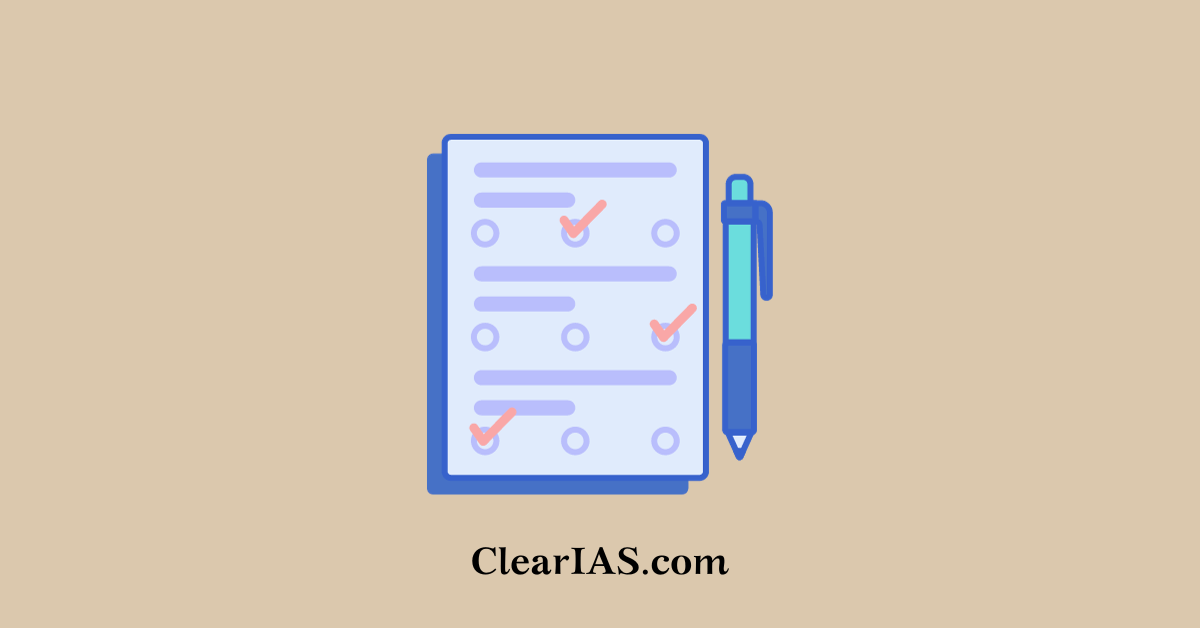
IAS Mains Model Questions: General Studies Paper 3
Aspirants who write mains are advised to go through these questions, answers written by other candidates, and the respective feedback from ClearIAS Team.

- Bank consolidation in India may create more risks than benefits. Critically evaluate the statement in the backdrop of the long term benefits of bank consolidation. (200 words – 12.5 marks)
- India’s climate policy has been constantly hobbled by many strategic concerns. Should India ratify the Paris Agreement considering that many developed nations have not yet ratified the agreement. Discuss. (200 words – 12.5 marks)
- ‘GST will change the way India does business’. Analyse this statement. Which sectors do you think will be positively affected by the implementation of GST? (200 words – 12.5 marks)
- The 92-year-old practice of presenting a Railway budget is set to come to an end from the next fiscal. Analyse the pros and cons of this step. (200 words – 12.5 marks)
- ‘Like the TFA on goods, there is a need for a counterpart agreement in services, an agreement on Trade Facilitation in Services (“TFS Agreement”)’. Discuss the statement in the background of India’s stand on the same at WTO. (200 words – 12.5 marks)
- The act of developing a technology is as much work inside the laboratory as it is of engaging with the state and society on various concerns and questions. Discuss the statement in the background of recent controversies around Genetically Modified Crops in India. (200 words – 12.5 marks)
- What is black money? Analyse the effectiveness of the recent measures taken by Government of India to tackle the menace of black-money. (200 words – 12.5 marks)
- What is climate smart agriculture? Climate-smart agriculture is crucial for India’s food security at a time of farm distress. Critically analyse. (200 words – 12.5 marks)
- Analyse why defense sector didn’t replicate the Indian success stories in Space, Nuclear or IT sectors. (200 words – 12.5 marks
- ‘India should Make for India and not for the world.’ Critically analyse this statement with reference to the current global challenges to Indian Economy. (200 words – 12.5 marks)
- What do you mean by Disruptive Technology? Discuss the scope of using Disruptive Technologies for Indian security needs. (200 words – 12.5 marks)
- Many believe the move to set up a public debt management cell will dilute the central bank’s role in the country’s money management. How true can this belief be? Analyse. (200 words – 12.5 marks)
- The Government must nurture young sapling of Islamic Banking in India so that the country may reap the benefit of its fruit in the coming years. Analyse. (200 words – 12.5 marks)
- ‘Since the only mechanism in Paris Agreement remains voluntary national caps on emissions, without even any guidance on how stringent those caps would need to be, it is hard to be optimistic that these goals are likely to be achieved’. With reference to the statement, critically analyse the scope of Paris Agreement in combating climate change. (200 words – 12.5 marks)
- Many doctors have suggested that legalising incentives for donors is the best way
to prevent exploitative middlemen connected with organ trafficking. Can this suggestion be approved in India? Analyse. What steps can be taken to prevent illegal trade in organs? (200 words – 12.5 marks) - There is the abundance of creative and innovative energies that flow in India, and the need to tap into and channelise these energies towards a better and brighter future for all. In the background of this statement analyse the vision of National Intellectual Property Rights Policy and its objectives. (200 words – 12.5 marks
- India is not threatened as much by a foreign power than it is by internal threats. Critically analyse. (200 words – 12.5 marks)
- Explore the linkage between terrorism and organised crimes. Can a Comprehensive Convention on International Terrorism (CCIT) break the linkage? Analyse. (200 words – 12.5 marks)
- Discuss the importance of Rwanda HFC agreement. Is the HFC ban be too little and too late? Critically analyse. (200 words – 12.5 marks)
- The Indian government is reported to have started the process of drafting rules for Section 67C of the Information Technology Act, 2000, India’s data retention law. Will privacy of Indian citizens be compromised? Critically analyse. (200 words – 12.5 marks)
- Is social service obligations the reason why Indian Railways makes losses in passenger services? Critically analyze the reasons in the backdrop of recent NITI Aayog report. Suggest measures to improve the condition. (200 words – 12.5 marks)
- With the passage of the Bankruptcy Code in May 2016, a complete overhaul of the debt recovery proceedings was envisaged. In this background, analyse the significance of The Enforcement of Security Interest and Recovery of Debts Laws and Miscellaneous Provisions (Amendment) Bill, 2016? (200 words – 12.5 marks)
- ‘Rural transformation on its own may not be effective in reducing poverty unless it is inclusive’. Discuss this statement in the background of India’s rural development programs and policies. (200 words – 12.5 marks)
- What are the policies and projects of the Government with respect to irrigation in India? Analyse the irrigation potential and its utilization in India. (200 words – 12.5 marks)
- Housewives from middle class households should be given due credit for India’s economic growth in the last decade and a half. Comment. (200 words – 12.5 marks
- Decentralisation has fallen off the agenda. Huge structural reforms are needed in panchayati raj system. Comment. (200 words – 12.5 marks)
- If there is one sector that needs the most of the punch line ‘minimum government, maximum governance’, it is aviation. Comment. (200 words – 12.5 marks)
- There is an urgent need to incorporate a sustainability perspective in Indian tourism. Comment on the reforms needed in Indian tourism sector. (200 words – 12.5 marks)
- Discuss in brief the cropping patterns in various parts of the country. Discuss the recent changes in cropping pattern in the background of climate change. (200 words – 12.5 marks)
- Modern Indian farmers have e-technology to aid them. Discuss the important e-technology programes and analyse the reach and effectiveness. (200 words – 12.5 marks)
Practice Full Length UPSC Mains Mock Tests – GS3
Please go through Clear IAS Mains Full Length Free Mock Test Series – 3 (GS3) and see how ClearIAS mock questions helped our online students in the actual UPSC main exam.
How to download the compilation of UPSC mock questions?
Every note published in ClearIAS.com has a print-pdf button attached at the post-bottom and at the left-margin. Alternatively, you can use the website ‘printfriendly.com’ to enter the URL of any posts in ClearIAS.com to download a clean, reader-friendly PDF.






MODERN FARMERS HAVE E-TECHNOLOGY TO AID THEM. DISCUSS THE IMPORTANT E-TECHNOLOGY PROGRAMMES AND ANALYSE IT’S REACH AND EFFECTIVENESS.
Agriculture on the surface of our mother earth is primitive even in the era of globalisation.E-technology to farmers is like a new area of knowledge emerging out of convergence.It gives better access to information which helps in increasing the productivity by ensuring food security,nutritional security,sustainable development and poverty alleviation.
To avoid digital divide,government introduced several schemes like NATIONAL TELECOM POLICY,2012 under which the mobiles are regarded as instruments of socio-economic empowerment for citizens,BHARAT NIRMAN aiming to provide right information at right time,MOBILE ENABLED KISAAN CARD SYSTEM helps the farmers for cashless transactions and various other schemes ensuring inclusiveness.
The major constraints of effective implementation of these schemes are very poor reach of technology as the large chunk of farmers are far away from such technological advancements.The educated farmers and rich farmers are becoming prosperous with the schemes while small and marginal farmers are not included in the path of development.
E-technology aid to farmers is an evergreen revolution in the field of agriculture.Literacy rate should be increased in the rural areas,government intervention must be placed and proper vigilance on implementation of policies is required there by ensuring that farmers are abreast the technological developments.Schemes and policies should not be rhetoric but should be implemented practically.